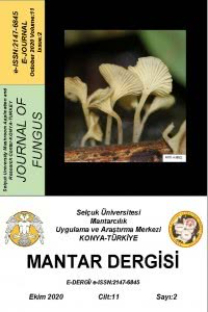Konya Selçuk Üniversitesi Hastanesi’ne Başvuran Hastalarda Saptanan Dermatofitler
Dermatofit, Dermatofitozis, Epidermophyton, Microsporum, Trichophyton
Dermatophytes in Patients Attending to Selcuk University Hospital in Konya
Dermatophyte, Dermatophytosis, Epidermophyton, Microsporum, Trichophyton,
___
- Agarwal, U.S., Saran J., and Agarwal, l. P. (2014). Clinico-Mycological Study of Dermatophytes in a Tertiary Care Centre in Northwest India. Indian J Dermatol Venereol Leprol.,80 (2) 194.
- Bilgili, M. E., Sabuncu, İ., Saraçoğlu, Z. N., Ürer, S. M., Kiraz, N., ve Akgün, Y. (2001). Kliniğimize Başvuran Dermatofitozlu Olgulardan İzole Edilen Dermatofit Türleri.Turkiye.Klinikleri.J.Dermatol.,11 (4) 185-190.
- Bindu, V., and Pavithran, K.(2002). Clinico-Mycological Study of Dermatophytosis in Calicut. Indian J Dermatol Venereol Leprol., 68 (5) 259–261.
- Coulibaly, O., Lollivier, C., Piarroux, R., and Ranque, S.(2018). Epidemiology of Human Dermatophytoses in Africa. Med.Myco., 56 (2) 145-161.
- Ebrahimi, M., Zarrinfar, H., Naseri, A., Najafzadeh, M.C.,Fata, A., Parian, M., Khorsand, I., and Babic, M.N. (2019). Epidemiology of Dermatophytosis in Northeastern Iran; A Subtropical Region. Curr.Med. Mycol., 5 (2) 16-21.
- Ergin,Ç., Ergin,F ., Yaylı, G., and Baysal,V. (2000). Süleyman Demirel Üniversitesi Tıp Fakültesi Dermatoloji Kliniğine Başvuran Hastalarda Dermatofitoz Etkenleri. Türk.Mikrobiyol.Cem.Dergisi.,30 (3-4) 121-124.
- Ergin,Ç., Ergin,Ş., Kaleli, İ., Şanlı, E. B., Cevahir, N., and Kaçar, N. (2004). Pamukkale Üniversitesi Hastanesi Dermatoloji Polikliniği’ne Başvuran Hastalarda Dermatofitoz Etkenleri. İnf. Derg.,18 339-342.
- Gül, Ü. (2014). Derinin Yüzeyel Dermotofit Enfeksiyonları , Ankara.Med.J.,14 (3) 107-113.
- Ilkit, M.(2010). Favus of the Scalp: an Overview and Update. Mycopahologia.,170 (3) 143-154.
- Jain, N., Sharma, M., and Saxena, V.N. (2008). Mlinico-mycological Profile of Dermatophytosis in Jaipur, Rajasthan. Indian J Dermatol Venereol Leprol., 74 (3) 274–275.
- Jha, B., Bhattarai, S., Sapkota, J., Sharma,M., and Bhatt,C.P. (2019). Dermatophytes in Skin, Nail and Hair among the Patients Attending Out Patient Department., J.Nepal.Health.Res.Counc.,16 (41) 434-437.
- Kechia ,F.A.,Kouoto, E. A, Nkoa T., et al.(2016). Epidemiology of Tinea Capitis Among School-Age Children in Meiganga, Cameroon. J Mycol Medicale.,24 (2) 129–134.
- LANGE, 2018. Tıbbi Mikrobiyoloji ve İmmunoloji, Ondördüncü baskı, Güneş Tıp Kitabevleri, s:404
- Moriarty, B., Hay, R., and Morris-Jones, R.(2012). The Diagnosis and Management of Tinea. BMJ.,344 1–10.
- Nweze, E., and Eke, I.(2017). Dermatophytes and Dermatophytosis in the Eastern and Southern Parts of Africa. Med Mycol., 56 (1) 13–28.
- Özekinci, T., Özbek, E., Gedik,M., Topçu, M., Tekay, F., ve Mete,M. (2006). Dicle Üniversitesi Tıp Fakültesi Mikrobiyoji Laboratuvarına Başvuran Hastalarda Dermatofitoz Etkenleri, Dicle.Tıp.Derg., 33 (1) 19-22.
- Rezaei-Matehkolaei, A., Rafiei A., Makimura, K., Graser, Y., Gharghani, M., and Sadeghi-Nejad B.(2016). Epidemiological Aspects of Dermatophytosis in Khuzestan, Southwestern Iran, an Update. Mycopathologia., 181 (7) 547–553.
- Sahai, S., and Mishra, D. (2011). Change in Spectrum of Dermatophytes İsolated From Superficial Mycoses Cases: First Report From Central India. Indian J Dermatol Venereol Leprol., 77 (3) 335–336.
- Seebacher, C., Bouchara, J.P., and Mignon, B.(2008). Updates on the Epidemiology of Dermatophyte Infections. Mycopathologia., 166 (5-6) 335–352.
- Theel, E.S., Hall L. , Mandrekar, J., and Wengenack, N. L.(2011). Dermatophyte Identification Using Matrix-assisted Laser Desorption Ionization-Time of Flight Mass Spectrometry. J Clin Microbiol., 49 (12) 4067–4071.
- Tümbay, E.(2002). Derinin Mantar İnfeksiyonları. Willke Topçu A, Söyletir G, Doğanay M., ed. İnfeksiyon Hastalıkları’nda. İstanbul: Nobel Tıp Kitapevleri, s:1785 –1797.
- Vineetha, M., Sheeja,S., Celine, M.I., Sadeep, M.S., Palackal, S., Shanimole, P.E., Das, S.S. (2019). Profile of Dermatophytosis in a Tertiary Care Center in Kerala India. Indian J Dermatol., 64 (4) 266–271.
- Woo, T.E.,Somayaji, R., Haber, R.M.,and Parsons, L.( 2019). Diagnosis and Management of Cutaneous Tinea Infections. Adv Skin Wound Care.; 32 (8) 350-357.
- ISSN: 2147-6845
- Yayın Aralığı: Yılda 2 Sayı
- Başlangıç: 2010
- Yayıncı: Selçuk Üniversitesi Mantarcılık Uygulama ve Araştırma Merkezi Müdürlüğü
Tanay UZGAN, Yiğit TERZİ, Füsun Bahriye UÇAR
Morchella esculenta ve Trametes versicolor’un İn Vitro Antimikrobiyal Aktivitesi
Kerem CANLI, Atakan BENEK, Merve ŞENTURAN, İlgaz AKATA, Ergin Murat ALTUNER
Fatih BAYDAŞ, Ebubekir ALTUNTAŞ
Pleurotus ostreatus (Jacq.) P. Kumm. Kullanılarak Dondurmanın Proteince Zenginleştirilmesi
İslam BEŞİR, Elif Sena KIRMIZIKAYA, Mahmut ÇAYLAR, Ferudun KOÇER
Merve KOÇAK, Sinan AKTAŞ, Fatih DURMAZ
Fuat BOZOK, Boris ASSYOV, Hatıra TAŞKIN, Saadet BÜYÜKALACA
Nezahat Gökyiğit Botanik Bahçesi'nin Mikrofungusları I.: Yeni Familya ve Tür Kayıtları
Bazı Uygulamaların Mantar Muhafazasında Kullanımı
Melek EKİNCİ, Ertan YILDIRIM, Atilla DURSUN
Eskişehir İli Tarım Topraklarındaki Isıya Dirençli Toprak Mikrofunguslarının Biyoçeşitliliği
Fatma AYVA, Goulsoum OUZEİR, Rasime DEMİREL, Burhan ŞEN, Ahmet ASAN, Duygu KADAİFÇİLER
